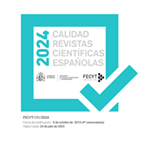La opacidad del cruising: ruinas, parques y otros escenarios del deseo (Valencia, Alicante, Castelló y Murcia, 1971-1978)
Resumen
En base a los expedientes del Juzgado de Peligrosidad y Rehabilitación Social de València (1971-1978), en este artículo se trazan los territorios y códigos velados del cruising que facilitaban encuentros sexuales consensuados y protegidos por la noche, las ruinas y el anonimato. Este mapeo desvela como las redes y la cultura “marica” se extendían desde los parques a los pisos privados hasta la centralidad de los gestos en un lenguaje coreografiado de reconocimiento mutuo. A través de los encuentros furtivos en espacios apartados de la visibilidad normativa, se construyeron sociabilidades paralelas para los iniciados, que podían así reconciliar sus impulsos eróticos con sus obligaciones diarias. El cruising se insertaba en los ritmos cotidianos de la vida urbana a través de las estrategias de la opacidad. De modo similar, los arrestados recurrían a un relato estereotipado sobre sus acciones, presentándose a sí mismos como autómatas de la noche para evitar desvelar la realidad de sus deseos y motivaciones. Para problematizar el mecanicismo propio de estos relatos, el artículo concluye con una polifonía de testimonios orales que muestran como la (des)valoración del cruising por parte de los partícipes guardaba relación con como vivenciaban su propia agencia en la promiscuidad.
Descargas
Descarga artículo
Licencia
La revista Cuadernos de Historia Contemporánea, para fomentar el intercambio global del conocimiento, facilita el acceso sin restricciones a sus contenidos desde el momento de su publicación en la presente edición electrónica, y por eso es una revista de acceso abierto. Los originales publicados en esta revista son propiedad de la Universidad Complutense de Madrid y es obligatorio citar su procedencia en cualquier reproducción total o parcial. Todos los contenidos se distribuyen bajo una licencia de uso y distribución Creative Commons Reconocimiento 4.0 (CC BY 4.0). Esta circunstancia ha de hacerse constar expresamente de esta forma cuando sea necesario. Puede consultar la versión informativa y el texto legal de la licencia.











